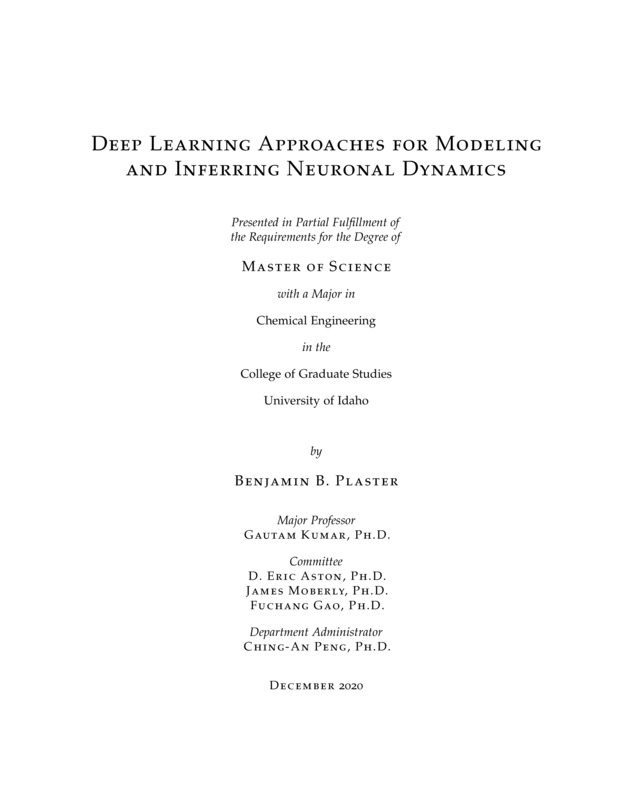Deep Learning Approaches for Modeling and Inferring Neuronal Dynamics
Plaster, Benjamin Bistline. (2020-12). Deep Learning Approaches for Modeling and Inferring Neuronal Dynamics. Theses and Dissertations Collection, University of Idaho Library Digital Collections. https://www.lib.uidaho.edu/digital/etd/items/plaster_idaho_0089n_12019.html
- Title:
- Deep Learning Approaches for Modeling and Inferring Neuronal Dynamics
- Author:
- Plaster, Benjamin Bistline
- Date:
- 2020-12
- Keywords:
- Data-Driven Deep Learning Modeling Neural Networks Neuroscience Statistical Inference
- Program:
- Chemical and Materials Science Engineering
- Subject Category:
- Neurosciences; Applied mathematics
- Abstract:
-
Recent developments in GPU-accelerated computing, as well as the advent of artificialintelligence and the rise of deep artificial neural networks (ANNs), have created a wealth of opportunity to explore purely data-driven computational modeling techniques on datasets and dynamical systems previously deemed overly complex or outright infeasible to model. One such example of a domain in which these questions are now being brought to light is in the field of computational neuroscience, where both single neuron and neuronal network dynamical responses prove difficult and arduous to model in many cases. This thesis work is dedicated to the development of computationally feasible, purely data-driven machine learning methods for inferring, learning, and modeling both single-neuron and many-neuron dynamics at multiple time-scales through novel employment of ANNs. The first portion of this dissertation focuses on the development of purely datadriven recurrent neural network (RNN) models of hippocampal CA1 pyramidal neuron dynamics in response to constant-amplitude applied external input. These CA1 pyramidal neurons exhibit highly nonlinear dynamics, with multiple bifurcations in behavioral response dependent on the magnitude of the externally applied input to the system. This approach involves the use of deep LSTM networks in conjunction with a novel translation trick borrowed from natural language processing (NLP) applications in language translation problems. We demonstrate that the network is capable of learning a complete representation of the dynamics, including multiple bifurcations in behavior. Additionally, we demonstrate that predictive accuracy of the devised LSTM network increases as the length of timeseries on which it is trained does as well. The second portion of this work focuses on the development of a generative machine learning method to infer firing rate dynamics of a neuronal population in an unsupervised autoencoding framework. This is centered around the idea that stochastic neuronal populations are better described using powerful rate-based dynamical models under the assumption that their firing activity can be described as a manyiv body nonhomogeneous Poisson point process. We use a sequential adaptation of a popular generative machine learning algorithm, the Variational Autoencoder (VAE) to infer firing rates that maximize the likelihood of the original data in an unsupervised manner, and demonstrate that this architecture is capable of discovering coherent dynamical representations of smoothed firing rates directly from binned spiking data.
- Description:
- masters, M.S., Chemical and Materials Science Engineering -- University of Idaho - College of Graduate Studies, 2020-12
- Major Professor:
- Kumar, Gautam
- Committee:
- Moberly, James; Aston, D. Eric; Gao, Fuchang
- Defense Date:
- 2020-12
- Identifier:
- Plaster_idaho_0089N_12019
- Type:
- Text
- Format Original:
- Format:
- application/pdf
- Rights:
- In Copyright - Educational Use Permitted. For more information, please contact University of Idaho Library Special Collections and Archives Department at libspec@uidaho.edu.
- Standardized Rights:
- http://rightsstatements.org/vocab/InC-EDU/1.0/

